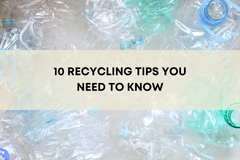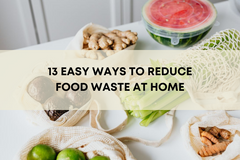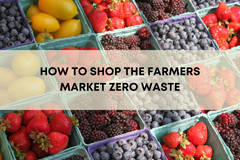In this series we’ll be looking at different ways to eliminate plastic from your kitchen, starting with food packaging.
As we all know, food packaging is hard to avoid. So much of our food these days by default comes packed in plastic.
In fact, single-use packaging is one of the biggest markets for plastic manufacturers. According to the EPA, containers and packaging like styrofoam egg cartons, bottles, and clamshells accounted for 14.5 million tons of plastic in America in 2017, most of which went to landfill. From landfill, plastic can leach toxins into the ground and waterways, and break down into tiny microplastics that are then virtually impossible to contain.
Plastic that doesn’t go directly to landfill often ends up in the recycling bin, where we like to imagine that it will be recreated into something new. In reality, on average less than 10% of plastic actually gets recycled – and even this small amount is hampered by the fact that it is straight up cheaper to make new plastic with cheap oil than it is to collect, separate and process old plastic for recycling.
These are all reasons why thinking about how to avoid plastic packaging from the very moment of going grocery shopping is important. The more packaging you can take out of your grocery cart to begin with, the less you’ll have wind up in your home to deal with later, and the more the environment will thank you.
Here are some strategies to help you figure out how to avoid unnecessary packaging:
Try buying in bulk. Tare Market and local co-ops have plenty of shelf-stable foods that you can buy in bulk in your own containers, saving all the additional plastic that would usually come with each individual packet of rice, beans, or pasta. You can even refill all your spice jars rather than having to buy a new plastic shaker every time you run out. If there’s an item you really want a lot of, we can special-order certain bulk products in large quantities for you.
Try buying in the biggest increment you can. If there’s a product you can’t live without that only comes in plastic, see if you can buy it in the largest size available (as long as it won’t go bad). The volume of plastic is likely to be lower than buying multiple smaller versions – and as a bonus you won’t have to go back to the supermarket so quickly (which saves on gas, if you drive your own vehicle).
Look for more sustainable packaging options like glass and aluminum. We’re creatures of habit, and when confronted with the vast array of choice at the supermarket, we often fall into buying the same brands over and over again. If you realise that these unconscious choices are wrapped in plastic, try to scan the shelves for more sustainably packed alternatives. Glass used for food and beverage containers is 100% recyclable, as are aluminum cans – and neither will break down into microplastics at their end of life. Be open to trying new brands and maybe you’ll discover something that you love and that comes in a recyclable packet. For example, rather than ketchup or mayonnaise in a plastic squeeze bottle, can you get it in a glass jar?
Give packaging the boot for fresh produce. Who came up with the idea of shrink wrapping bananas anyway? Plenty of fresh produce doesn’t even need a plastic wrapper – it has its own natural skin to protect it. Try to pick produce that doesn’t come pre-packed – and see if you can forgo popping items into a plastic bag. I often leave mine loose in my basket if I’m just getting a few things, or I use cotton mesh bags if I’m picking up a lot of produce. When I checkout, I ask if I can use my own cotton tote bags to pack my groceries into. At the end of the day, we should all be washing our fruit and veggies thoroughly once we get home anyway, so why waste a plastic bag just to get them from supermarket to kitchen?









